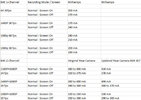rcg530
Well-Known Member
- Joined
- Jan 23, 2021
- Messages
- 1,556
- Reaction score
- 2,608
- Location
- California
- Country
- United States
- Dash Cam
- BlackVue, Thinkware, VIOFO, Vantrue, Blueskysea, FineVu
I test the recently upgraded B4K 1080p rear dash camera. It has an upgraded Sony Starvis IMX307 image sensor.

